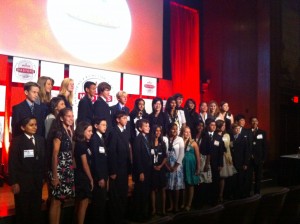WASHINGTON — On Tuesday, the Society for Science & the Public announced the top winners of the inaugural Broadcom “Math, Applied Science, Technology and Engineering for Rising Stars” competition out of 30 finalists from middle school science fairs around the country.

The 30 finalists in the Broadcom MASTERS middle school science competition were honored at the Carnegie Institution for Science on Tuesday in Washington.
Among the finalists was 12-year-old Chad Campbell of Hampstead, N.C., who was recognized with the “Rising Star” award for his project on testing for antibiotics in meat purchased from local grocery stores.
“I learned that 15 percent of the meat I tested had antibiotics, and that it further leads to antibiotic resistance,” Campbell said. “It kind of changed my perception about meat by learning that they’re giving the cattle this stuff we use to treat modern illness. It’s kind of crazy, but it’s true.”
Campbell traveled to Washington with two other students from North Carolina: Justin Barber, 14, of Raleigh, and Andrew Blonsky, 12, of Chapel Hill.
“These Broadcom MASTERS demonstrate the potential of our youth to succeed,” said Elizabeth Marincola, president of SSP. “They exemplify what people of any age can do, if given the right encouragement, direction and support.”
The finalists were treated to tours of historic sites and organizations that celebrate science, technology, engineering and mathematics, according to Jennifer Baumgartner, spokeswoman for the Broadcom Corporation. On Tuesday, they visited the White House to meet John Holdren, the president’s adviser for science and technology, along with other officials from the Office of Science and Technology Policy, before the evening’s award ceremony.
“I love the technology and engineering prospects of science,” Barber said. Through his project, which tested wind resistance of various roof designs, he said he discovered his passion for architecture and engineering.
Blonsky, on the other hand, found what he doesn’t want to do in the future.
“I learned that I really should not try to work with living organisms,” he said about his project, which tested the ability of algae to reduce carbon dioxide. “They’re just way too unpredictable.”
He is still focused on a career as a mechanical engineer, however, and wants to continue looking into ways science can improve the environment.
“I like how math and science easily applies to the world around us and how much they relate to each other,” Blonsky said.
In addition to the national spotlight, each of the 30 finalists will receive a $1,000 donation to their school. Students and their teachers will each get an asteroid named after them through the Ceres Connection program, which names minor planets discovered the Lincoln Near-Earth Asteroid Research Program.
The top award and $25,000 went to 15-year-old Daniel Feeny of Woodside, Calif., for his project on wave forces in the intertidal zone on a beach in California.
